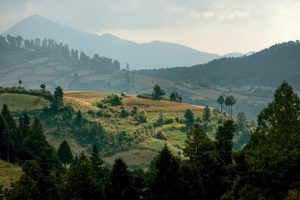Support Hidden Compass
We stand for journalism, science, history, and hope. Make a contribution to Hidden Compass and stand with us.
The motorcycle scrambled higher, the road wove tighter, the air grew colder and thinner. As I climbed, I felt a pounding in my temples; I wondered if my lungs would run out of oxygen. Mostly, though, I felt the isolation.
It was February of 2022, and I was traveling deep in the Himalaya, to the once-forbidden province of Upper Mustang in Nepal. As far as I could see there wasn’t a single strand of grass — no bushes, no trees. No living creatures either — not even a bird.
The loud exhaust whirring of the unregistered Chinese dirt bike was amplified by the freshly bulldozed roads. Amazingly, the rickety 200-cc cycle had pulled me all the way up here — 13,800 feet above sea level — without a hitch.
I’ve spent the past few years immersing myself in foreign surroundings like this as often as I can. Nothing fulfills me more than venturing into the unknown — where anything and everything can be a revelation — and documenting my experiences in words and images.
But this was a different kind of journey for me.
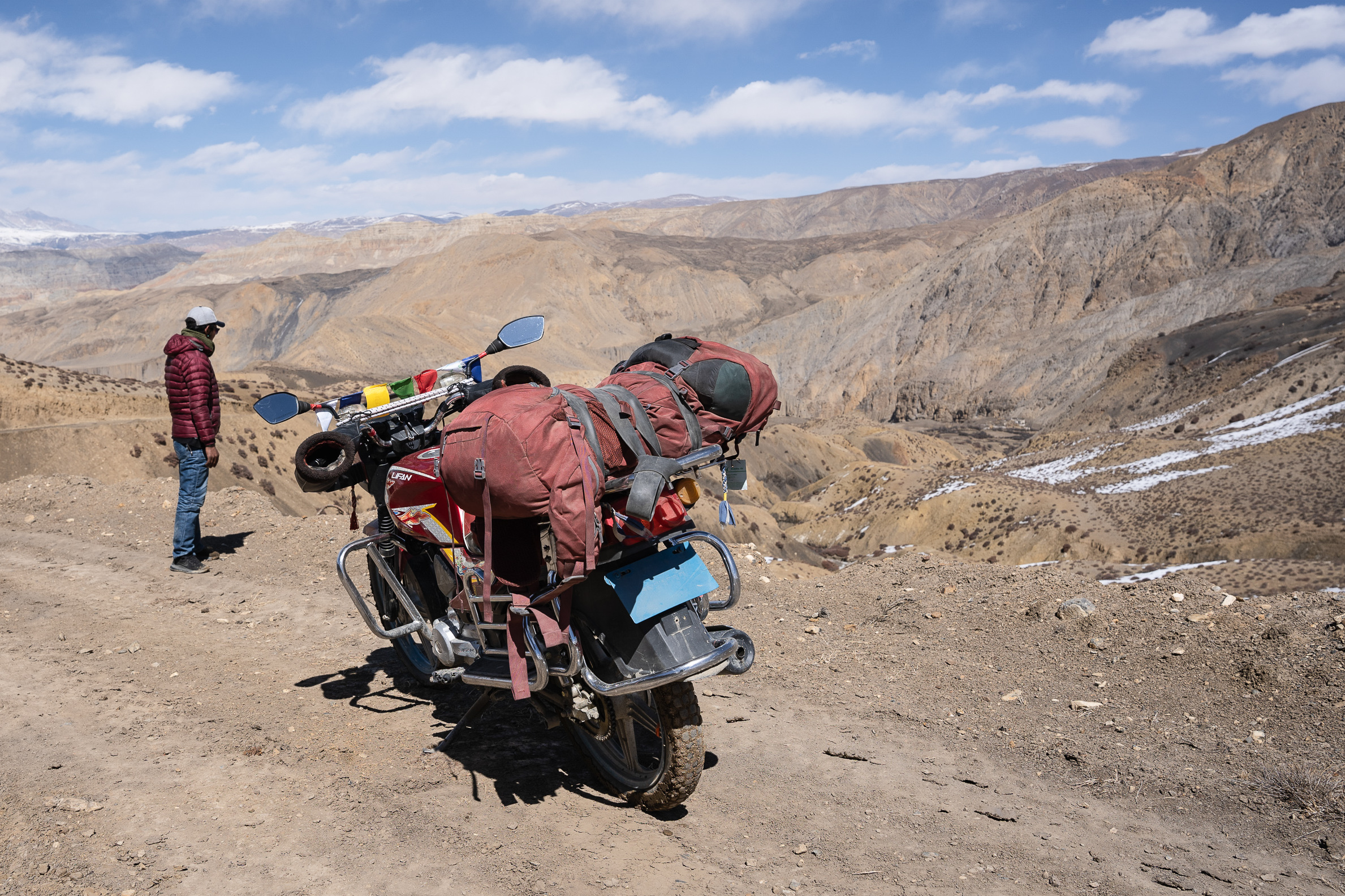
To reach the remote Nepali region of Upper Mustang, the author traveled by plane, jeep, foot, horseback, and unregistered 200-cc Chinese motorcycle. Photo: Tulsi Rauniyar.
~~
Growing up on the southern plains of Nepal — usually referred to as the Madhesh region — I never heard about the odysseys of women from our village. In fact, I’m the first woman in my family to venture north into the Himalaya. Our women were born on the plains, and they are still there. Most never leave.
The women who came before me had their own battles, which they fought every day. My mother lost her first child due to lack of health-care access. My grandmother married at the age of 13. My aunt was landless and penniless after my uncle died, thanks to Nepal’s discriminatory citizenship laws.
Being a Madhesi, especially a poor and female one, often meant being deprived of education and employment. It meant having an indifferent, ineffective government. It meant you were a “corner person.”
That’s what people who live on the margins in Nepal call themselves — women especially, but plenty of men too. Anyone here who ekes out a rural subsistence and feels forgotten or beside the point.
I’ve always wanted to write about the corner people — people who aren’t usually written about. And I’ve always wondered how other corner people live. Do they ever complain about their circumstances? The ones I grew up with — especially the women — never did. They called their lot in life “fate.” It was something they considered inexorable. Something they had to bear for their children. Something that never changed.
She says this place is far too dear for her to ever leave. Even though staying here is literally killing her.
During one of my previous treks I’d heard about Dhye — a village where severe drought, caused by a vanishing glacier, had forced most of its residents to scatter in search of new homes. Only a few had stayed behind — a handful, nearly all women, whose stubborn presence was the settlement’s tenuous lifeline.
Poverty, climate change, underdevelopment, migration, loss of identity and history, women left behind — all the realities Nepal’s corner people face seemed distilled in the life, and slow death, of one village.
That’s what drew me so far from my ancestral home in the Terai plains, where Hinduism is dominant, to this remote, largely Tibetan Buddhist section of the country, once known as the Kingdom of Lo. I wanted to witness firsthand how these corner people live — to ask the women of Dhye why they didn’t leave like the others, and to talk to those who did. I wanted to hear their stories.
And honor their lives.
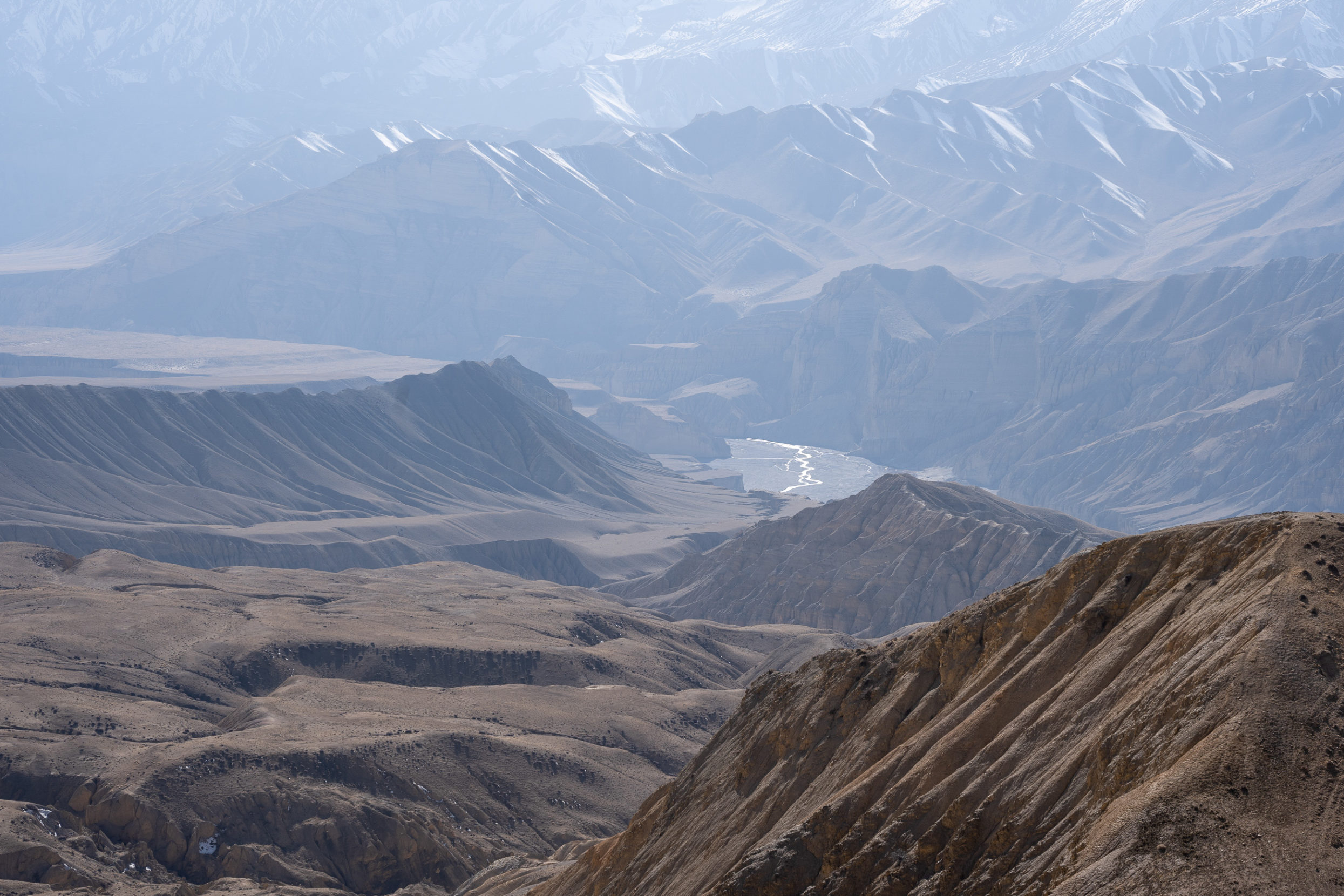
Once known as the Kingdom of Lo, Upper Mustang — a high-altitude hub of Tibetan Buddhism — first opened to Westerners in 1992. Photo: Tulsi Rauniyar.
~~
After four days of travel — first by plane, then by jeep, foot, horseback, and dirt bike — I reached my destination. There, at the literal end of the road, I saw the village of Dhye, forbidding in its emptiness.
I passed through its wired gates and wandered its cracked, cobbled lanes. Dhye was built more than 400 years ago, and little has changed: thatched mud houses with whitewashed walls, a Tibetan Buddhist monastery, surrounding lands so arid and bleak they’re almost lunar. It seemed as if time had stood still.
Smoke billowed from several chimneys, indicating clay hearths inside a handful of homes. But most houses were silent and covered in thick dust. Some looked like they’d been left in haste. Peering through empty window frames, I glimpsed snapshots of lives lived — and households abruptly left.
Smashed crockery, broken chairs. A blanket made from a yak pelt. A corroded baby’s bottle on the floor. Shreds of prayer flags like strips of skin. A dirt-stiffened blouse on a counter, threaded with strips of turquoise and pink.
Why did they leave so hastily? I wondered. What happened here?
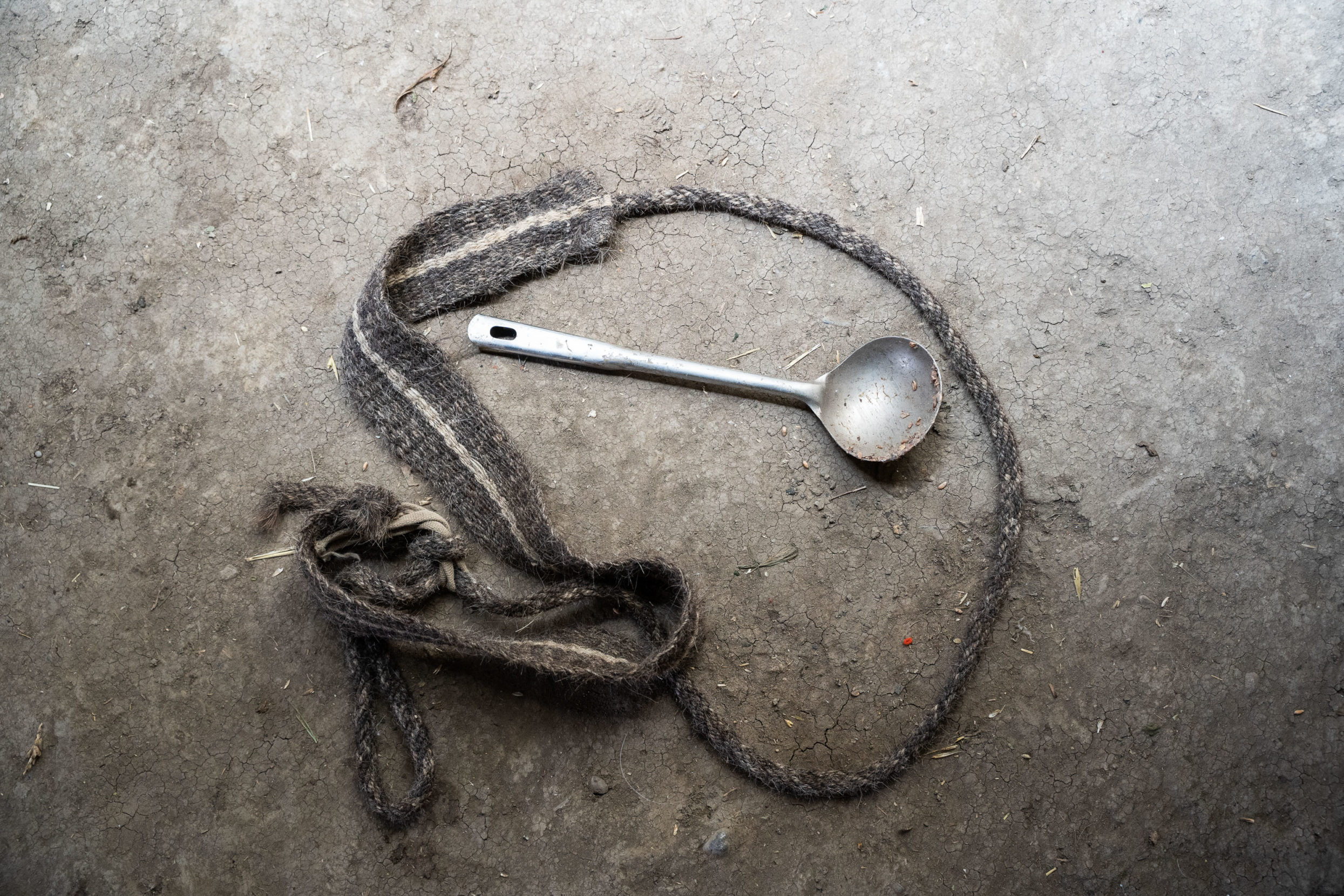
Years after most of the villagers fled drought-stricken Dhye in search of new lives, abandoned artifacts of daily life still litter the ground. Photo: Tulsi Rauniyar.
~~
A few hours later, as the sun was setting, a round-faced woman opened her front door and welcomed me into her house. Inside, the two-story structure shook with every step I took.
Kancho Dolkar’s long black hair was pulled back into a loose ponytail. Her fingers were encircled by a heavy set of polished beads. Though only 52, she looked far older — a sun-creased study in exhaustion.
I wanted to hear their stories. And honor their lives.
Speaking hoarsely and deliberately in broken Nepali, with a heavy Tibetan accent, Kancho told me how everything fell apart.
How 25 years ago an upstream glacier — the villagers’ only source of freshwater — melted faster than anyone could have reckoned. (The glacier, which sat about eight miles north of Dhye, had no official name, but the locals referred to it as “Fuchhme.”) How fields were ruined. How livestock with bloated bellies littered the ground.
When households were forced to share a single pond, there wasn’t nearly enough water to irrigate the land. And as temperatures rose, further water scarcity loomed. The Nepalese government seemed unlikely to intervene. Day-to-day life in the village collapsed.
The village elders decided that everyone should migrate 30 miles west, to the banks of the Kali Gandaki River. Over the next five years most of the village cleared out. Residents strapped clothing and food to their horses and hiked to the chosen site, where they built a new village and named it Dhye Khola (for that stretch of the river).
Yet a dozen or so residents decided to stay in Dhye, among the gray, eerie ruins — the silent streets and empty houses with incongruously locked gates.
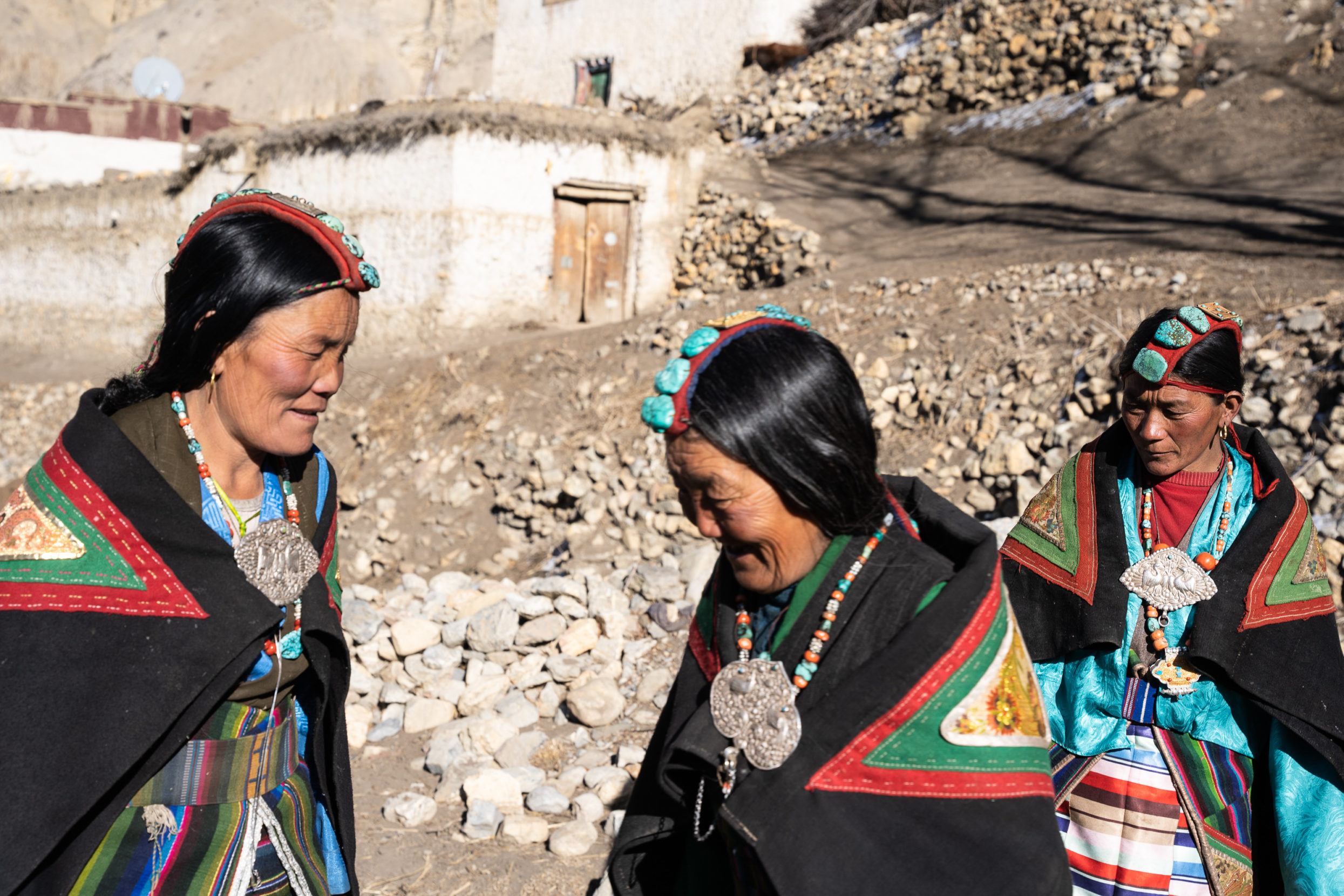
Wearing beads, headdresses, and other traditional attire, three of Dhye’s last holdouts, including Kancho Dolkar (right) and Nim Choden (left), share a moment in the sun. The women are preparing for Hyoom Puja, an annual harvest ritual. Photo: Tulsi Rauniyar.
Before I turned up on her doorstep, Kancho hadn’t had a visitor in more than a year, other than her husband, Jamyang Chruidar. He was among those who decamped for Dhye Khola. Kancho loves him, but her ancestral home is their family’s only asset. And it’s all she knows; her family has lived here for four centuries. Shaking her head, she says this place is far too dear for her to ever leave. Even though staying here is literally killing her.
At night her frequent deep, wheezing coughs — a symptom of chronic obstructive pulmonary disease, which causes breathing difficulties — seems to come from the back of her chest.
“I blame the cold. Once the summer is here, I can sleep peacefully without waking the village up,” she says with a rueful chuckle. “In winters, the cold leaks from my every orifice.”
Kancho says surviving illness or injury here feels like a matter of luck. Paved roads have connected other villages and made health care accessible elsewhere in Upper Mustang. But not in Dhye. Traveling for treatment is not an option. It’s simply too expensive.
Entire branches of Kancho’s family tree have departed. The siblings who used to tell her stories, the cousins who played with her in the Sky Caves above Dhye, her seven children — they’ve all left for the promises of elsewhere.
Poverty, climate change, underdevelopment, migration, loss of identity and history, women left behind — all the realities Nepal’s corner people face seemed distilled in the life, and slow death, of one village.
Today, virtually every household in the village is composed of a single woman. Family members arrive in summer to help harvest the few crops that still struggle to life here: barley, wheat, buckwheat, and potatoes. But they leave before the bitter winter sets in.
“There is no school, no electricity, and no connectivity here,” Kancho says. She adds that even before the drought, “yak herders were struggling to find grazing patches for their animals, and our men couldn’t provide for our children. Once the drought hit, the children were crying, newborns were dying — they were screaming — and everyone felt like they had failed.
“We thought the gods were angry.”
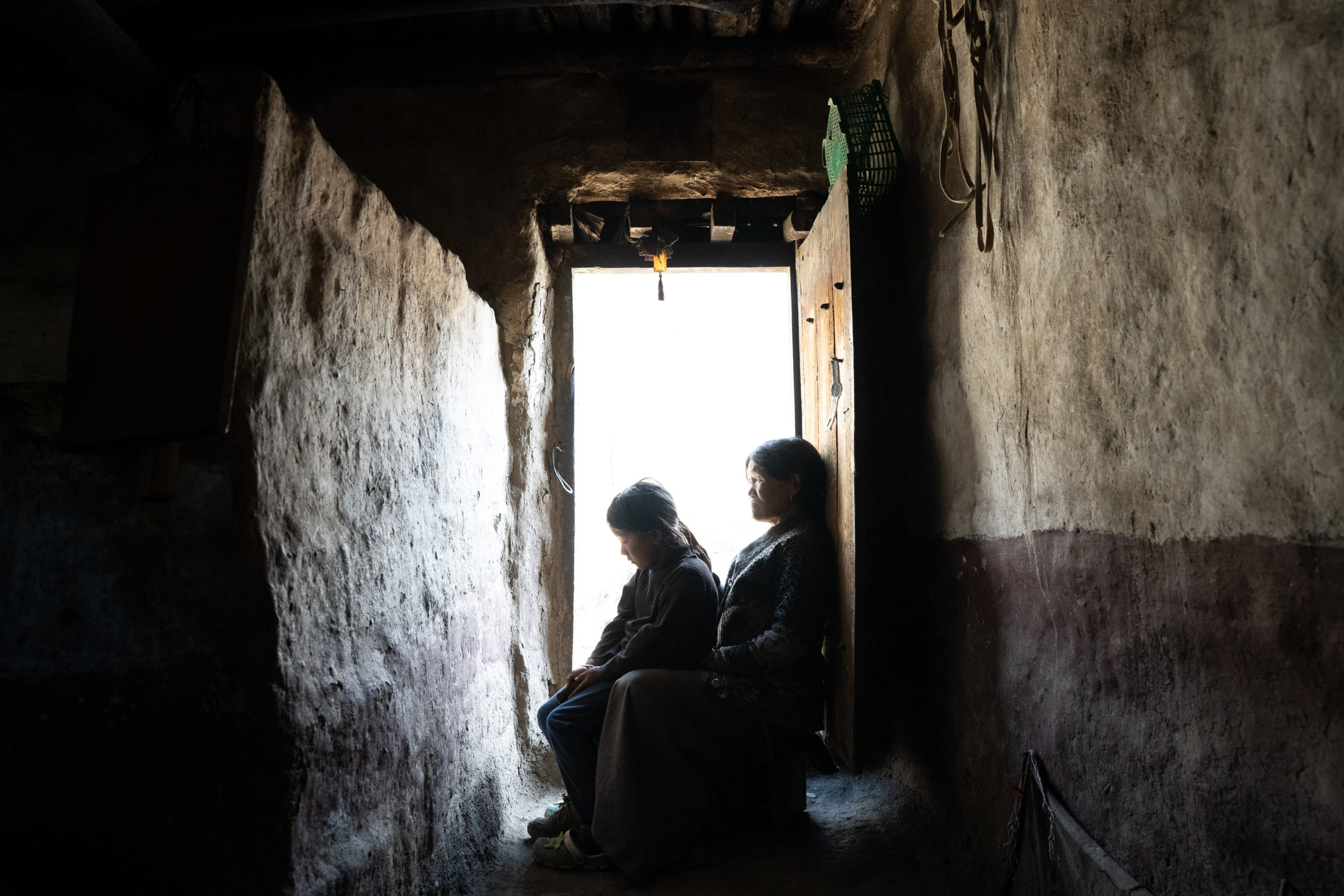
Kanchi Tashi and her granddaughter, who is visiting from another village, sit silhouetted in a doorframe. Today, the younger generation is often sent to nearby cities, where they attend school and grow accustomed to a more modern life. Photo: Tulsi Rauniyar.
~~
I followed Nim Choden into her kitchen as the late afternoon sun illuminated a dying willow tree outside her living-room window. Inside, the smell of yak meat filled the air. Stooped and graying, with a care-lined face, Choden sat next to a clay stove, throwing yak dung-cakes into it to heat water.
Choden says the drought was clearly divine retribution — punishment for the killing of a yeti. At some point in the distant past, she says, during a time no one can quite remember, the villagers of Dhye slew one of these creatures, a staple of Himalayan folklore said to inhabit the upper reaches of the 1,500-mile long mountain range.
Years later, says Choden, the Buddhist principle of karma was activated. In this case, it created an environmental calamity: extreme drought.
“The responsibility for disasters lies with us,” she says firmly. “If we do bad things, then bad things will happen. We cannot blame the mountains. We cannot blame the Dalai Lama.”
Upper Mustang is a Tibetan exile community, a semi-independent kingdom. Ancient Tibetan culture and traditions continue to thrive here in a few tight-knit communities. They retain a Tibetan way of life, speak their own language, and have kin across the border in China.
For centuries the Tibetan Buddhist monastery in Dhye was a core part of village life and culture — a spiritual bastion and an active presence in day-to-day affairs and governance. But that too has changed.

Life slowed to a trickle after the sole source of freshwater — an upstream glacier that villagers called “Fuchhme” — vanished in a matter of years. Photo: Tulsi Rauniyar.
~~
I looked up and saw a domed earthen roof supported by a small forest of splintering wooden pillars. Water was leaking from it — drip, drip, drip. Some of the intricately carved beams were choked with ivy too. The clay and gravel walls around me were starting to flake and crumble badly.
As Dhye’s pastures have turned to dust and its streams have been reduced to an oily trickle, its century-old monastery has begun to fall apart. The art depicting Buddhist deities I saw inside was decomposing. The ancient artifacts and faded scriptures were in disarray. Maps were curling at their edges, and the statues of sacred deities that rose to the ceiling were covered in inches-thick dust.
“We [used to] go to the monastery for spiritual safety and well-being,” says Choden. “But now it appears as though the monastery itself needs protection.”
The last monk left Dhye years ago. Today, says Choden, no one’s here to lead daily meditations or organize traditional events like the Tiji Festival, a three-day harvest celebration held each May. It’s traditionally a vibrant, colorful affair, with wildly dressed celebrants — usually younger people — praying, chanting, and dancing.
But the young people have left Dhye. The festival hasn’t been held here for years.
“Without a community of people,” says Choden, “without monks to give life to our age-old customs, speak our language, and sing our folk songs, it seems like our culture will slowly be strangulated.”
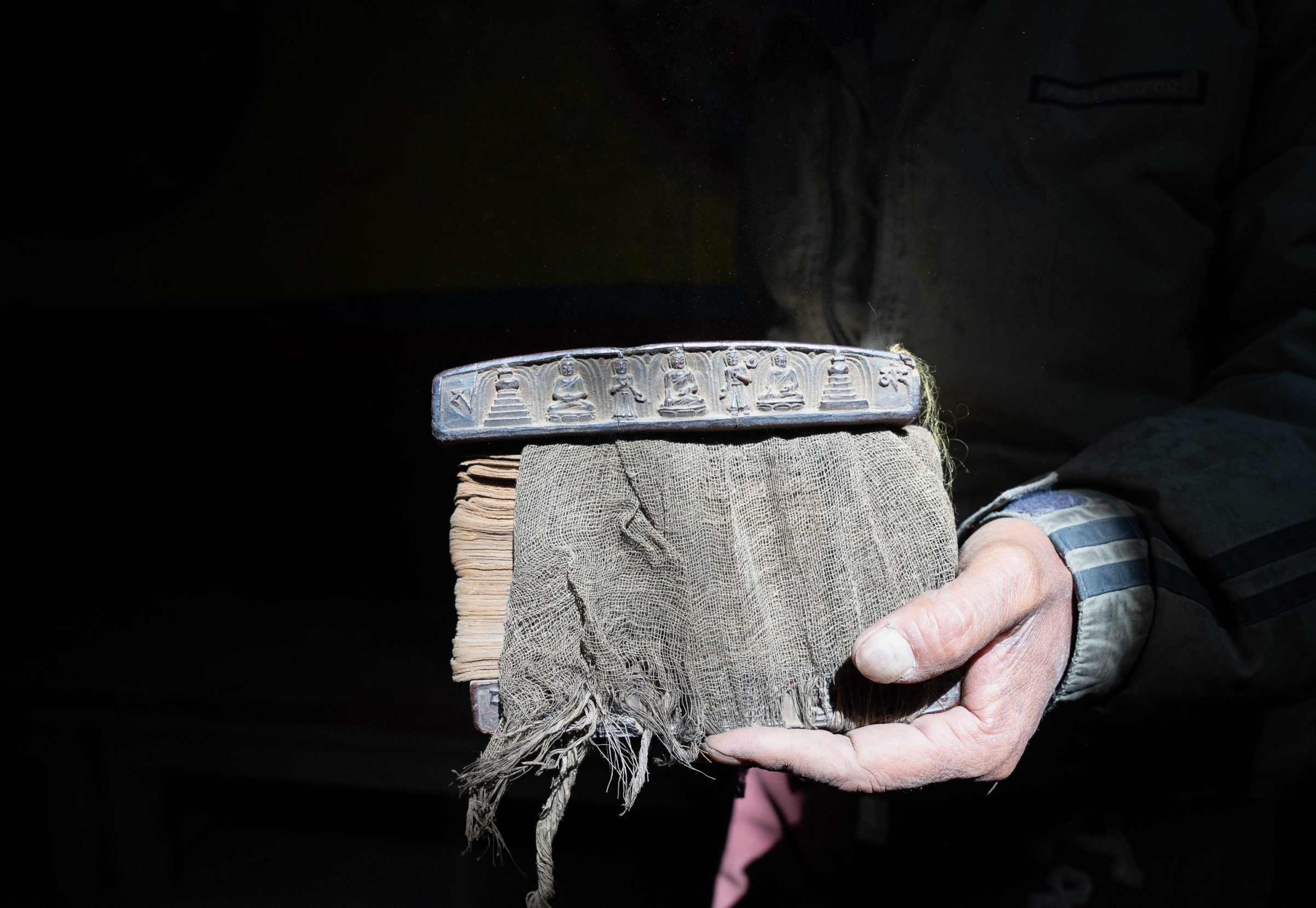
With no monks to maintain Dhye’s century-old monastery, cloth is fraying and scripture is fading. Photo: Tulsi Rauniyar.
~~
“Come on!” called Pasang Tashi. “You got this! Try hard!”
I was trying hard, walking as briskly as I could behind the young translator I’d hired. But as I stood on the edge of a sheer cliff, light-headed and gasping for air from the climb, I was not at all sure I had this.
When I met Pasang earlier that day, in a village alley festooned with prayer wheels, he was wearing faded jeans and a red jacket. The only male left in Dhye is 24 years old — young for a corner person.
He was standing next to his horse, Kali, whom he’d dressed in a long traditional saddle and fur, with a small wooden falcon perched on top. I felt like I was about to have butter tea with a Tibetan emperor.
With all the younger folk long gone, Pasang has to perform all the rituals, all by himself.
Pasang had just returned from a tough trek, to an altitude of 16,400 feet, to collect wood for the village. He said he wasn’t his best self that day — every part of him was in agony from the climb. Nonetheless, the smart, sardonic young man agreed to accompany me to the Sky Caves.
A vertical series of more than 10,000 caverns dug into the steep valley cliffs above Dhye — as though an urban high-rise had been inserted above the gorges of the mighty Kali Gandaki — the Sky Caves are among the region’s most precious, least understood sites. Inside, crusty earthen walls and soaring domed ceilings are carved with images of fanged, turquoise-skinned creatures. Butter lamps illuminate the interiors, issuing soot, smoke, and grease into the dry cavern air.
Villagers say the Sky Caves may have once been burial chambers. A scientific survey in 2017 found ancient pages of Buddhist texts, paintings from the 14th and 15th centuries, and precious beads of indeterminate origin. Traveling ascetics from the oldest school of Tibetan Buddhism are believed to have performed tantric yoga here.
The views aren’t too shabby either.
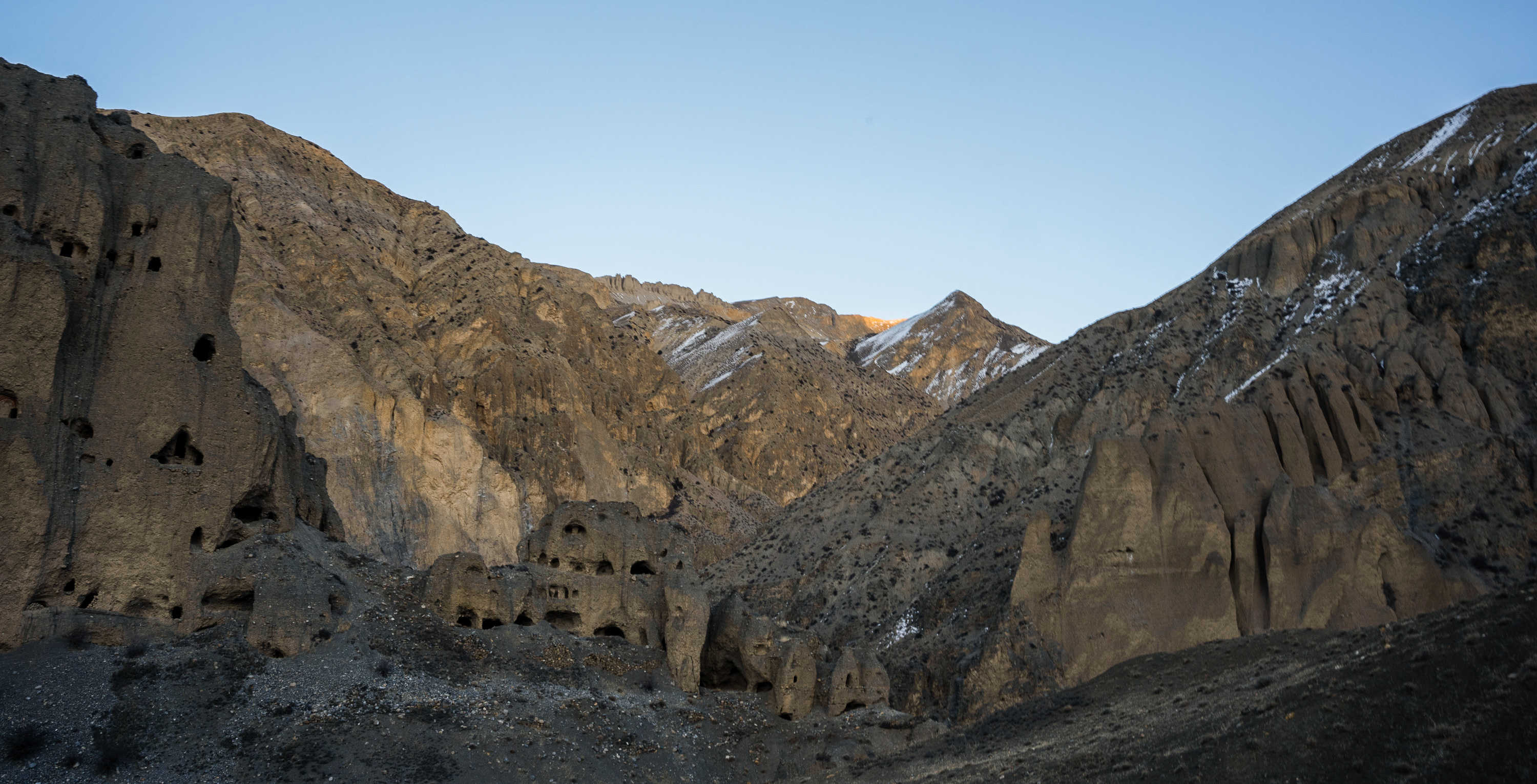
The Sky Caves of ancient Dhye. In Mustang, some 10,000 caverns are carved into the vertiginous cliffs. Through millennia, they’ve been used as burial sites, shelters, and meditation retreats. Photo: Tulsi Rauniyar.
~~
Looking out from a cave ledge, Pasang and I could see a freshly bulldozed road stretch from Dhye to the horizon. Narrow and accessible only to four-wheel-drive vehicles — and totally impassable for most of the winter — it does not support public transportation. Locals often take horses wherever they’re going.
Less than a decade ago, a network of new roads was laid across the rugged terrain of Upper Mustang. The years-long building boom, now in a widening and blacktopping phase, is being funded by the Nepalese government, international development agencies, and neighboring donor countries such as China. It’s part of an ambitious national effort to build roads to every settlement in Nepal, whose government emphasizes decentralized economic growth.
But in the country’s most remote areas, the grim irony is that these roads may be completed just as some of the places they’re reaching vanish forever. Places like Dhye.
As Pasang says with a sigh, “Our friends and family started leaving on the same roads that were supposed to bring us opportunities.”
As a Tibetan folk song blared on his no-network phone, Pasang went on: “We barely have visitors here anymore. A decade ago some trekkers and pilgrims visiting [the sacred lake] Damodar Kunda … would pass through Dhye. But not anymore. There are other valleys with better facilities and thriving tourism. Nobody prefers coming to this corner. Those who left think we are foolish to stay back.”
Pasang’s family and friends left years ago, but he didn’t want to leave his family’s ancestral house. And unlike the many pastoralists here who have sold their herds, Pasang said he could never part with the yaks he grew up with. Nor could he move them to Dhye Khola. These bovines have roamed the highlands for centuries; they can’t thrive in the warmer climate of the new village.
Pasang was nonchalant, but I could sense an aura of loneliness around him. He admitted that he sometimes dreams about what his life would be if he’d moved to Kathmandu and pursued a formal education.
But if Dhye has a future, it will require Pasang to play a starring role. He was clearly already indispensable.

Dolkar looks over the dry expanse of Dhye as a villager approaches. Photo: Tulsi Rauniyar.
Some Tibetan Buddhist rituals, for instance, require younger people to perform them. One such tradition, unique to Dhye, is a harvest puja called Dhimpuche, in which celebrants gather around a pine tree at the north end of the village. (That particular tree is so central to the ancient ritual that children who have left Dhye are no longer able to celebrate Dhimpuche.)
After a monk — or, in the absence of a monk, a local — chants prayers, everyone makes an offering for a bountiful harvest. Children then perform a series of verbal and movement-based rituals. The day ends with a celebratory feast of thin bread that looks like a millet pancake.
Now, with all the younger folk long gone, Pasang has to perform all the rituals, all by himself.
He also looks after what’s left of the village livestock and gathers firewood for the women of Dhye so that they can cook and warm their houses. When there’s a medical emergency, Pasang fetches help.
He told me that he hopes his sacrifices will honor his ancestors. Then a sad look crossed his face. He said he doesn’t want everything they’ve built over the past 400 years to die.
When I began to call Pasang, the only male and relative youngster left in Dhye, “the last man standing,” he laughed and shrugged, then asked me, with a nervous grin, “Is that something good or bad?”
I wasn’t sure what to say.
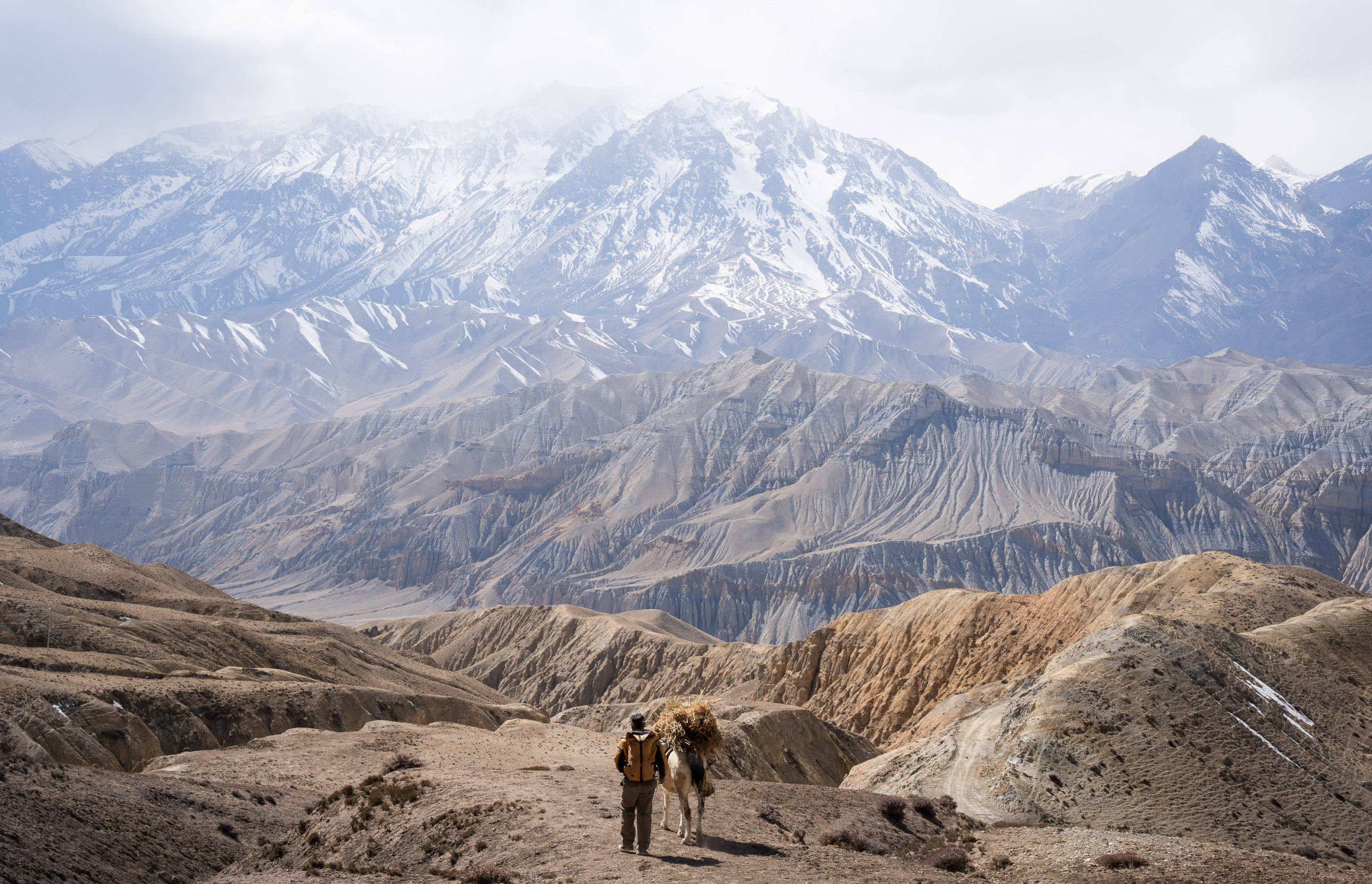
For “the last man standing” in Dhye, and the few remaining in other villages, life can be lonely. Photo: Tulsi Rauniyar.
~~
The hotels, souvenir shops, and general stores in this village are bustling. The scent of Italian coffee fills the cafes. Trucks and motorcycles pass over smoothly paved streets, carrying necessities and conveniences. An ambulance is parked on the main drag, ready to ferry the sick or injured to the nearest health facility.
Lo Manthang is the closest village to Dhye — a two-day trek during winter or a day’s drive in the summertime. On clear nights you can see its glow on the southeastern horizon. But in terms of health, education, and living standards, it might as well be on another planet.
When Upper Mustang opened to Westerners, in 1992, Lo Manthang was ready. Its residents were tired of being corner people, and soon made their village one of the most desirable trekking destinations in the remote Himalaya. Thirty years later, the regional economy — which once depended on pastoralism, agriculture, and bartering — has been taken over by the adventure travel industry, with its gas stoves, mobile phones, laptops, and North Face jackets. Today tourists seem to outnumber locals here.
All that prosperity has passed Dhye by. The water scarcity plus a lack of proper infrastructure and digital connectivity has sent visitors to other places.
Politicians don’t seem ready to help. Dhye’s survivors complain that they have little say about local issues, and that their grievances aren’t represented in national discussions. They say they hardly know what’s happening in their district or the country at large.
In some ways, I thought, the realities of life in Dhye are much like those of ours on the plains, hundreds of miles away. The central government in Kathmandu has never paid much attention to the corner people. Why would it start now?
~~
When I met Lhamu Tsering on a cold afternoon, her ruddy cheeks were covered in dirt and dust. This childhood friend of Kancho Dolkar had clearly spent the day working on her apple farm. Her hair in braids, she wore a loose, silk-belted garment fastened at the neck and spoke Nepali haltingly.
Lhamu moved to Dhye Khola two decades ago. Not because she wanted to, but because she felt she had to.
She was pregnant for the fourth time. She’d lost her first three pregnancies and was stricken by the thought of another baby emerging lifeless. That her husband would migrate elsewhere and never return. That she’d be all alone.
Every morning during the drought she prayed for rain. For deliverance. For a healthy child.
Yet Lhamu lost her fourth child as well.
“We thought the gods were angry.”
“When I needed a doctor,” she says, “I had to rely on prayers. In winter the roads were covered in heavy snow … I [couldn’t] leave Dhye, nor could my husband fetch doctors from the nearest health post, which was more than a day’s ride on a horse.”
A year later, when she was pregnant again, they went to Pokhara, the nearest city. There she gave birth to the eldest of her two sons. And realized that her life in Dhye was over.
“The prayers were not enough,” she says. “We had to leave, and so with a heavy heart, we did. I think that made me the way I am today — a little sober, a little serious.”
Lhamu and the others who left Dhye say there’s more opportunity in their new village. Despite the arid landscape, apples grow well in the southern part of this district, which relies on snow for irrigation during the dry season.
Having seen nearby settlements like Jomsom and Marpha do well with apple farming, villagers in Dhye Khola staked out fertile areas, built irrigation canals, and bought seeds. The first apple farm, which started as an experiment, now has more than 10,000 trees. The Bessin Association in Nepal, a French aid agency, has helped plant more apple trees and build concrete homes.
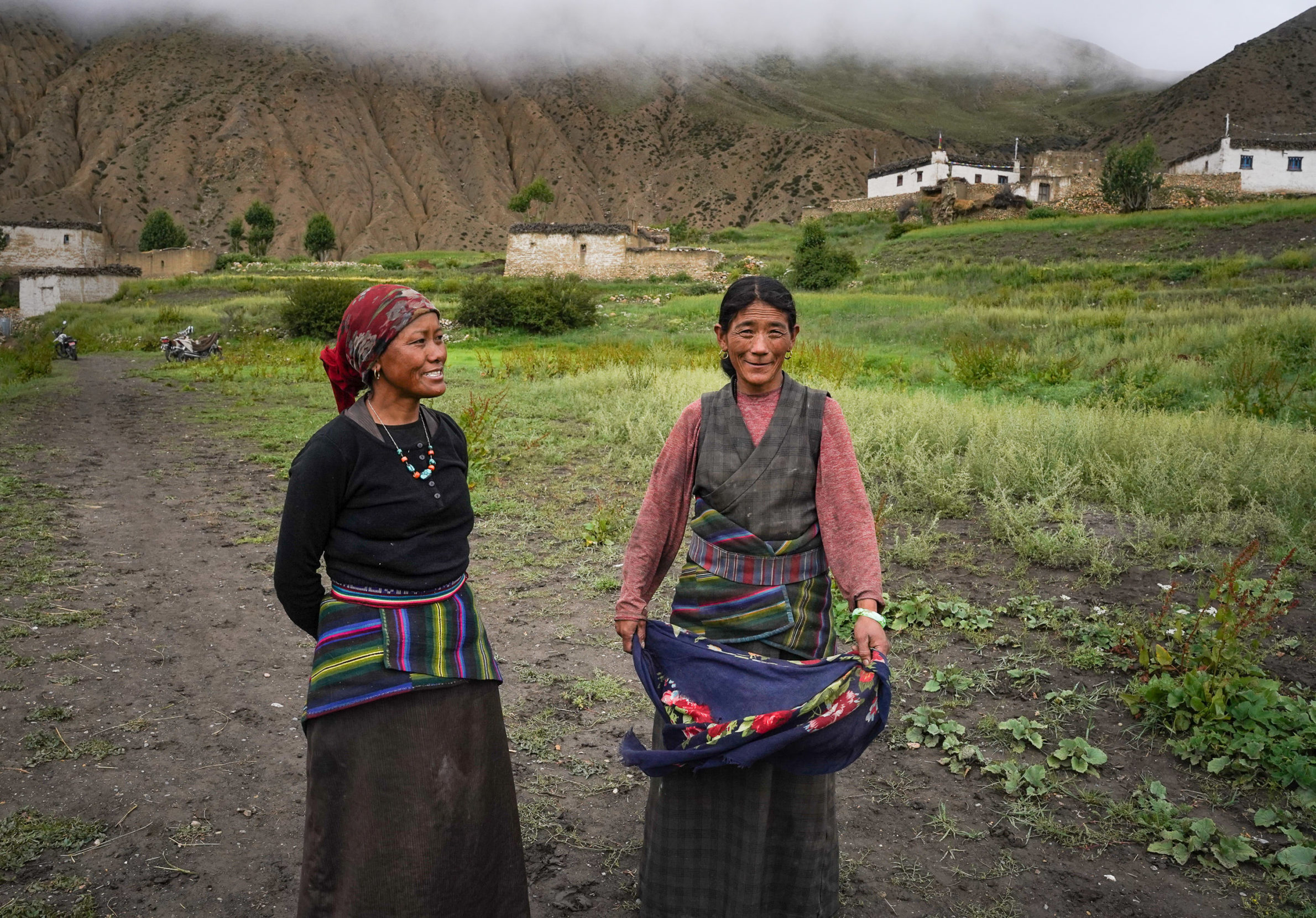
Choden and her friend Sonam share their harvest with the camera. In the face of collapse, the women of Dhye are able to grow only a few crops — barley, wheat, buckwheat, and potatoes. Photo: Tulsi Rauniyar.
But challenges abound. For example, a recent increase in red mites, apple maggots, and codling moths, which farmers have unsuccessfully fought with pesticides and chemical fertilizers. This year’s production has been at least 10% smaller than last year’s.
In recent years the number and intensity of storms has increased, and the amount of rainfall has risen. The rain-swollen Kali Gandaki River has eroded its banks, threatening the settlements along it — Chusang, Lubra, and now Dhye Khola, which is seated at the base of the deepest gorge in the world — every monsoon season, which lasts from June to August.
“The responsibility for disasters lies with us,” she says firmly. “If we do bad things, then bad things will happen.”
Lhamu says the settlement process in Dhye Khola is an issue as well. The village still isn’t recognized by the federal government, which means its residents — officially classified as climate migrants — don’t have a legal right to the land. They have a hard time procuring credit from banks to build houses and selling their apples at market for a fair price, thanks to local taxes levied on agricultural products from unregistered farms.
When I said goodbye to Lhamu, part of me wondered if those who’d left Dhye for Dhye Khola had simply traded one corner for another.
~~
As the thin rays of evening sun slanted across Kancho Dolkar’s porch, the women swayed together and hummed as one. Their eerie, lovely melody — keening and melancholy, in a lyrical-sounding language few can still understand — rose into the brisk, dry air.
The women wove as they sang, spinning yak wool on a spindle or weaving the yarn on a traditional loom called Tangmo nei. In two weeks’ time their hands would be holding sweaters and shawls to keep out the chill.
Only 10 women were there that evening — all of those left in the village of Dhye — yet it felt like many more were present. Perhaps their ancestors could still be felt, summoned into living memory by words in the local Lo-pa dialect.
The next day I left Dhye on its single, rough road. As I moved away from the shadows of the snowbound peaks, I thought of those who had left and those who had chosen to remain, whether out of fear, pride, stubbornness, or faith.
Dolkar’s words rang in my ears. “If we’re going to die, let’s die at home. Otherwise, what was it all for? But it’s just one thing that makes my heart bitter: When we die, this village, our home, might die with us.”
~~
In Terai, too, the wisdom of our ancestors — coded in stories and songs, language and ceremony — is on the verge of extinction. The things we’ve lost over the years — cultural sites and religious shrines, secular events and sacred rituals — have dealt a grievous blow to our community’s sense of self.
Just like the women of Dhye, the corner people of the plains feel the ache and pressure, as time grows short, to try to preserve as much of the wisdom and as many of the memories as we can. Because we too sense that when the last women leave us, we’ll be devoid of something essential — an irreplaceable part of our heritage, and the stories that define us.
He doesn’t want everything they’ve built over the past 400 years to die.
Of course, I’m a leaver too. In 1996 my parents packed their bags and hopped on a bus for Kathmandu. My mother went because her husband decided to go; she didn’t have much choice. My father’s heart swelled with pain, leaving behind what he had always called home.
They said that they were leaving so that I could have a better life. They said that we would reunite with our community soon, though the date was unspecified. They said that I had to study and work hard in the city.
Though I was a child, I understood that my parents had left our village for my sake. They wanted to give me things, and I had to do other things in order to repay them. It was simple math, and it was not traumatic.
Yet my real identity — the one that follows me around like a shadow — is that I am the daughter of people from the corners. I too learned to call my lot in life “fate.” Even in the big city, far from the corners, it was something I considered inexorable. Something I had to bear for my future. Something that would never change.
Perhaps, I think, there’s wisdom in living as Dolkar does — as if loss weren’t a central part of her life. She’s a corner person, after all. She knows how to persist. Every day she moves from prayer to prayer, in a place that once blossomed but is now nearly barren. Every evening she sits on a porch with her remaining friends and drinks sweet butter tea, sings traditional songs, and weaves yak wool.
On my first night in Dhye, I strolled through the village with her. Despite her infirmities, she walked ahead of me, pointing out imperfections in the cobbled streets. She wanted to make sure I didn’t slip and fall.
“If you care about something,” she said, “you want to ensure that it is always in peace and safety. Don’t you agree?”
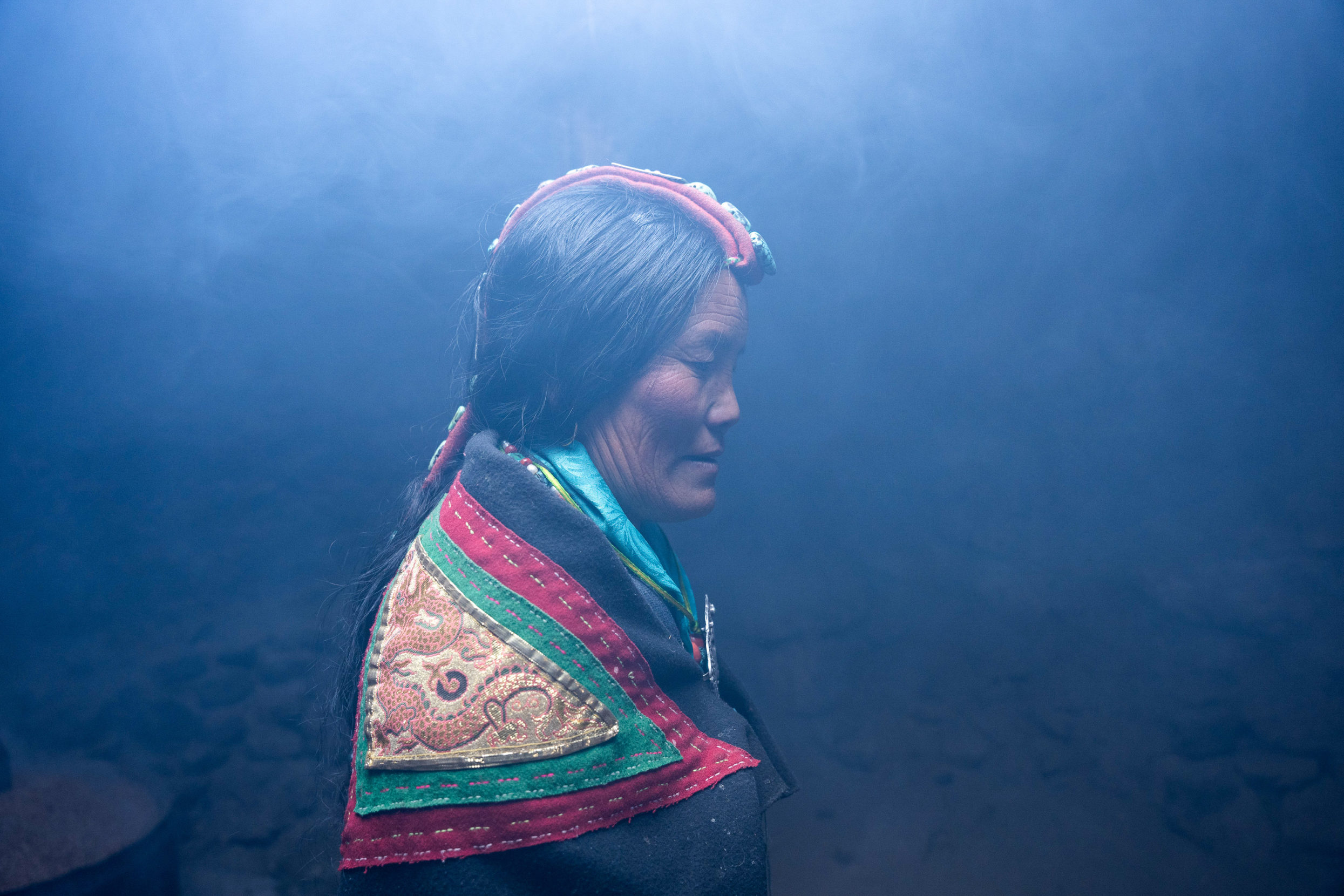
Dolkar stands by the fire preparing fermented barley. For the “corner people” of Nepal, daily survival means living as though loss — of culture and heritage, ceremony and community, ancestral wisdom and memories — wasn’t a central feature of life. Photo: Tulsi Rauniyar.
Tulsi Rauniyar
Tulsi Rauniyar is an independent journalist and documentary photographer based in Kathmandu, Nepal. She infuses new perspectives into her work around environmental and humanitarian issues — an intersection of worlds that needs critical thinking and heart.
Never miss a story
Subscribe for new issue alerts.
By submitting this form, you consent to receive updates from Hidden Compass regarding new issues and other ongoing promotions such as workshop opportunities. Please refer to our Privacy Policy for more information.


